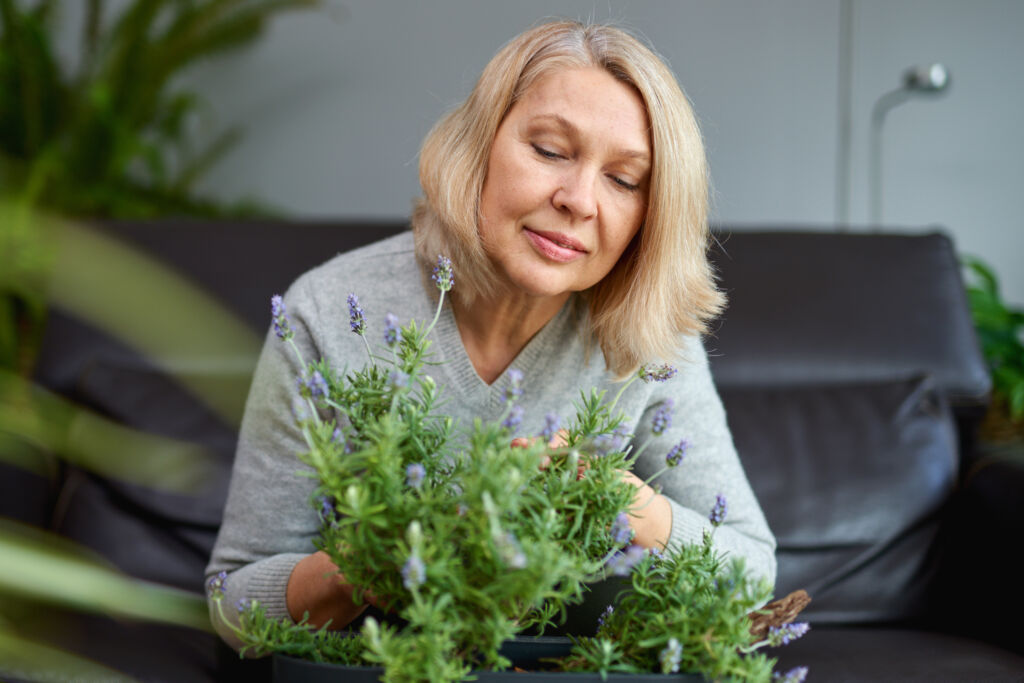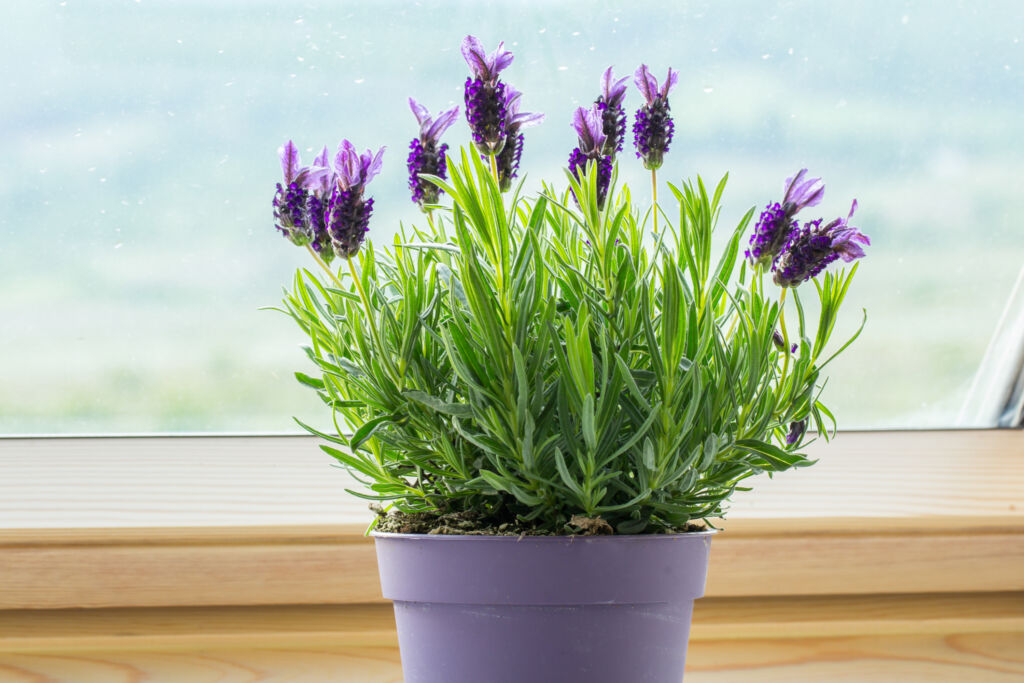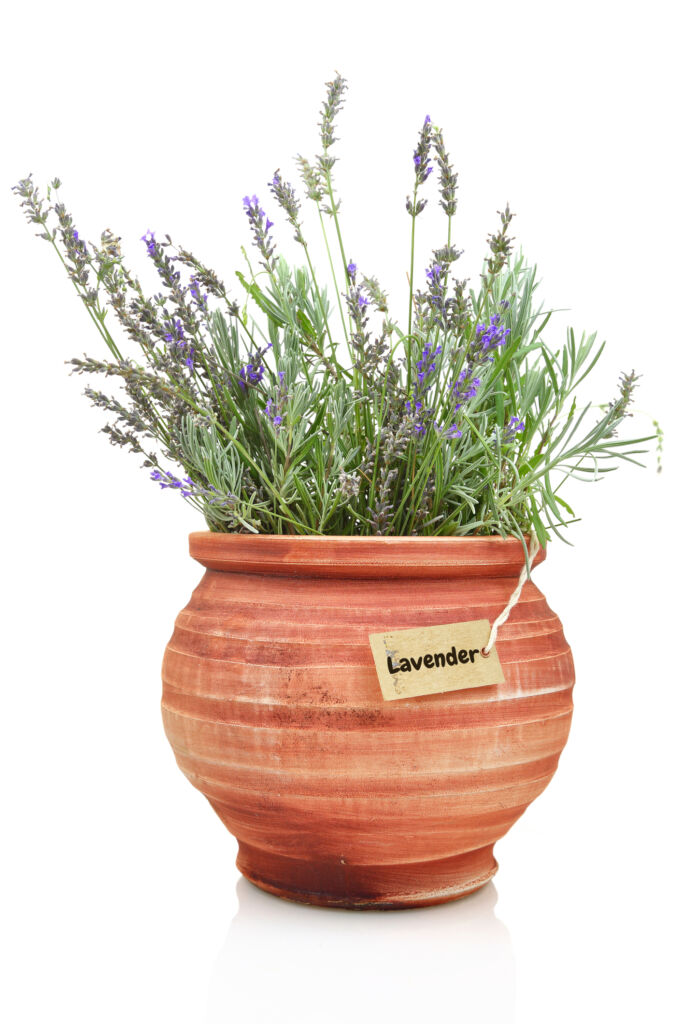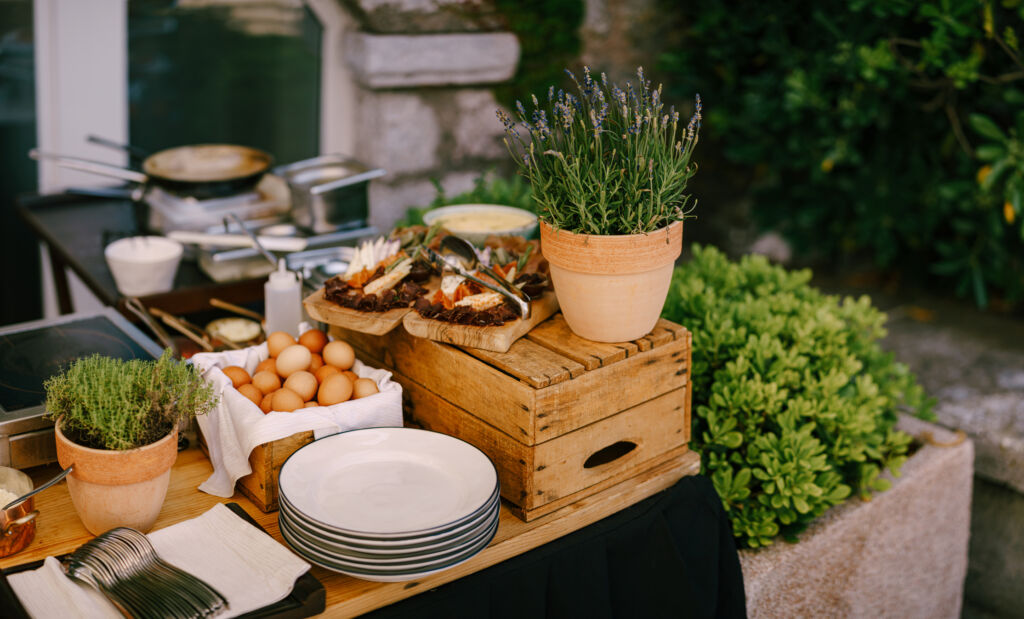HousePlantJoy is supported by our audience. When you purchase through one of our links, we may earn a small affiliate commission. As an Amazon Associate I earn from qualifying purchases. Your cost is not affected.
==================
Make Lavender Plant Indoor Care Work
Lavender plant indoor care is worth it when done right. Belonging to the Mint family, it’s a fragrant angiosperm or flowering evergreen shrub. Many appreciate its aroma and also use it for cooking. Gardeners also use it as an ornamental plant for its calming blooms. Due to its varied benefits, folks across the globe grow it outdoors and indoors. Also, this hardy shrub can branch and spread to be a perennial plant. It will be as such when under favorable conditions. So it shows why many have a Lavender house plant.
Proper care turns this plant into a blooming and gorgeous shrub. It may be a hardy plant, but it has specific requirements when inside. This post includes tips to grow it and Lavender health benefits. Hence, read on to get more information about it.
Why Lavender Plant Indoor Care Matters
This shrub grows well with proper treatment when inside. It needs attention and some care to look good. It won’t be as decorative, healthy, and productive as it should be with poor treatment. So setting its environment and providing for it is crucial. It requires support even if it adapts well to various conditions. Still, it becomes possible to avail Lavender health benefits with a healthy plant. Hence, this shrub will only manage some neglect when indoors.
It’s also a good idea to put this plant inside due to its ornamental design. People arrange bundles of it in wicker baskets and tin buckets. Putting the dried flowers in a vase serves to accessorize a home too. The shrub can also deodorize sections of a house with its aromatic leaves. So folks put it on windowsills and countertops in the living room, kitchen, and other areas. Even so, those grown outdoors need to acclimate when placed inside. Thus it’s beneficial yet somehow challenging to have a Lavender house plant.
Soil and Fertilizer For Lavender Plant Indoor Care
A high pH or alkaline soil is ideal for this shrub. It doesn’t need and rejects having a lot of water due to its drought tolerance. The woody, fibrous, and shallow roots it has can rot and have a fungal infection due to overwatering. The environmental alkalinity provides the shrub with plenty of plant macronutrients. Yet it’s the soil that also reduces phosphorus and other micronutrients. The deficiency results in unfavorable effects to root growth. Hence, it can do well with a water-soluble fertilizer with a high phosphorus content. Even if it has delicate roots, it still requires elements to let it thrive.
People use blood meal, bone meal, and kelp fertilizers for the Lavender house plant. Due to their nutrient concentration, folks dilute them in water. They have high phosphorus content and are slow-release and organic fertilizers. Applying them in diluted form to soil allows for a cozy environment too. Doing so contributes to the ground’s alkalinity over time. Folks often use fertilizer during springtime or in early summer when it starts to grow. They apply it at half-strength every four weeks or so. Transplanting is also best during those times since it’s when the shrub is active. Thus consider these points when taking care of the shrub. These strategies may help you achieve Lavender health benefits.
Watering Lavender House Plant
Lavender plant indoor care involves watering too. The plant enjoys being in a warm and dry area, but it can get thirsty. During spring to summer, it needs to get its root ball wet every week. Watering it once every two to three weeks will suffice when it matures. Exposing it to drought can sometimes be beneficial to it. When it’s too wet, its root may rot or develop a fungal problem. Thus it’s also essential to put it in a quick-draining pot when inside. A container with grit, pebbles, and holes at the bottom will encourage water drainage. So there must be a limit when watering this plant for its safety.
A Lavender house plant goes dormant during wintertime. It loses leaves and flowers beforehand and becomes inactive when it gets cold. Since it cannot withstand freezing temperatures, putting it indoors is essential. As for its water requirements, there should be a significant reduction. Water the shrub when the topsoil turns dry. Never attempt to hydrate it when the soil around it feels damp and cold. Consider this even when the plant is somewhere warm within your home. When the plant droops and leaves start turning yellow, it may mean overwatering. Thus it pays to be careful when hydrating this plant.
Light For A Lavender Shrub
Providing adequate lighting is essential in Lavender plant indoor care. This plant does so well when outdoors and in warm climates. Putting it near windows or open areas during winter can help when the daytimes are shorter. It thrives in hot environments with constant and bright sunlight exposure. Yet it cannot withstand heavy moisture and intense cold. Also, a Lavender house plant can survive and grow well while inside. As long as vivid lights are available for hours, it will manage.
One of the Lavender health benefits is it helps with mental health. Looking at it provides a relaxing view and may help achieve stress relief. Placing this potted shrub outdoors in spring or summer can make it look good. The light and warmth will let it show lush green foliage and cool-colored flowers. This arrangement is ideal during the growing season. Hence, it’s healthy for the plant to bask beneath the sunshine for 8 hours or more. The sun exposure will allow it to do photosynthesis and produce food for itself. Long hours of getting light can let it show better leaves, roots, and blossoms.
Lavender Pruning and Pest Control
Part of the Lavender plant indoor care involves trimming parts of it. Regular removal of dead, rotting, and excess leaves, branches, and roots will make it look great. Yet timing its pruning is crucial too. Even if taking off dead parts are essential, it’s best to do some trimming during spring or summer. At that time, the plant isn’t dormant and continues to grow. This plant gets stressed when compelled to respond to stress during winter. Also, pinching off or cutting the lifeless parts allows new sections to develop. So a Lavender house plant requires shaping for its management.
Included as Lavender health benefits is its nature to deter pests. It delivers strong smells that repulse a few insects. Examples are mosquitoes, flies, fleas, and moths. Yet it also attracts some bugs, like butterflies and bees. It illustrates why people put extracts of this shrub in pet repellents. The fragrance controls bug infestations. Even so, it’s a plant that experiences infestations. Froghoppers, whiteflies, and aphids invade sections of its foliage. Neglecting their presence is a problem. But at least these creatures are not difficult to prevent and remove. Checking the shrub, cleaning its surfaces, and putting it in well-lit spots may help deal with the bugs. Thus, due to the pruning and pest control indoors, it necessitates some attention.
Lavender Health Benefits and Appearance
Its attractiveness and other favorable features make Lavender plant indoor care worth it. This flowering plant has about 74 species and comes in 450 varieties. But the various types have similar attributes. Each of them has a visual appeal and delivers Lavender health benefits. For this reason, people identify, appreciate, and take care of it. Because of its look alone, it encourages relaxation and recovery. Folks also extract essential oils from it through steam distillation for aromatherapy. Smelling its scent helps relieve insomnia, allergies, and other diseases. Some people add and consume its parts in beverages and savory dishes. So a Lavender house plant is a worthy companion to prevent and treat ailments.
Varieties of this beneficial angiosperm look pleasing. They have modest foliage with grayish and greenish hues. Also, these leaves may have narrow, broad, elongated, and serrated shapes. Still, the flowering shrub displays dispersed pink, lilac, purple, and blue blooms. Delicate and calming floral scents are identifiable when near it. Hence, it’s why gardeners across the globe recommend it. It’s a low-maintenance, beautiful, and functional plant.
To Wrap Things Up
Thank you for reading this post about Lavender plant indoor care and more. It’s an attractive shrub that cleans the air and has therapeutic properties. Folks appreciate the said features of it and its low-maintenance nature too. These favorable qualities make it worth keeping, yet it’s a plant with requirements. It must have plenty of daylight or auxiliary light and shouldn’t be too wet. It needs to undergo regular pruning and other treatment too. Besides, it turns beneficial with proper care. So having it and taking care of it is a good decision.
Have you grown a Lavender house plant? What was it like to care for it? We hope you learned a thing or two about this fascinating angiosperm through this post. Please share your experience and pictures of the said shrub with us. We’re happy to receive ideas and experiences from our readers about houseplants.








